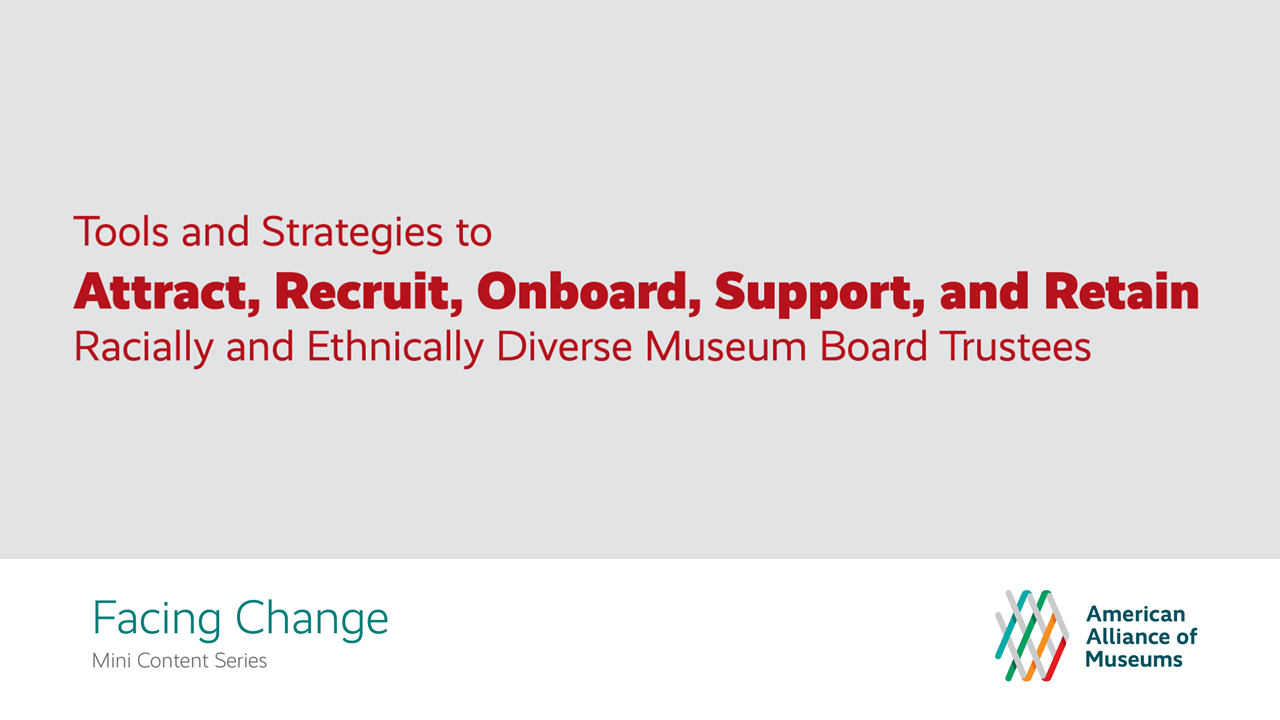
Introduction
(This video runs 1:58)
Navigation
Content Description
The following content was derived from resources developed during the American Alliance of Museums’ Facing Change initiative (2019-2021). This initiative supported participating museums’ efforts to diversify their boards of trustees. These resources consist of a series of five video conversations between Andrew Plumley, former Senior Director of Equity and Culture at AAM, and Beth Zemsky, consultant on the Facing Change initiative, where they explore their perspectives on board development.
- The first video focuses on attracting potential trustees through engaging community members, building knowledge and interest in the museum, and diversifying networks.
- The second video focuses on recruiting by actively and intentionally engaging specific community members from racially and ethnically diverse backgrounds and identities, directly stating your goals for outreach.
- The third video focuses on onboarding as distinct from orientation and discusses how to welcome new members to the board, and how to foster an ongoing environment of learning and collaboration.
- The fourth video focuses on supporting trustees, specifically how to keep board members engaged and create a sense of inclusion and mission alignment.
- The fifth video focuses on retaining trustees, particularly the importance of keeping board members active within your boards, building resiliency, and planning for the future.
Learning Objectives
- Understand the importance of the five phases of diversifying museum boards
- Develop skills and knowledge to initiate a process for making your museum board more racially and ethnically diverse
- Introduce tools to empower board members to create meaningful change within their museum’s board structure and processes
How to Use this Resource
This resource is designed for use with board members and museum staff that work directly with the board. Board nominating and governance committees in particular may benefit from engaging in this series as a group. The webinar videos total three hours and forty-five minutes. We recommend breaking up the content and your discussions across five sessions, with 45 minutes to an hour dedicated to watching the video and 30-45 minutes dedicated to discussion and activities. Feel free to adjust the time allocations based on the needs of your group.
Each video section contains: supporting documents; guiding questions and webinar highlights; discussion prompts; and optional activities designed to reinforce key points and themes.
The questions listed under “discussion prompts” are suggestions. Select questions to discuss with your group and supplement those questions with other relevant questions as you lead the discussion.
We recommend providing copies of the supplemental worksheets that accompany each video to participants, as well as notepads/paper for participants to take notes. This will provide opportunities for participants to reflect on their own experiences and practices as you complete this webinar series.
Videos
Attracting Racially & Ethnically Diverse Board Trustees
Recruiting Racially & Ethnically Diverse Trustees
Onboarding Racially & Ethnically Diverse Trustees
Supporting Racially & Ethnically Diverse Trustees
Retaining Racially & Ethnically Diverse Board Members
Key Terms[1]
- Action Learning: The active use of critical analysis of past processes and actions to inform future actions
- Dominant Culture: The established language, religion, values, rituals, and social customs on which a society was built. It has the most power, is widespread, and influential within a social entity, such as an organization. An organization’s dominant culture is heavily influenced by the leadership and management standards and preferences of those at the top of the organizational hierarchy.
- White Dominant Culture: Culture defined by white men and women with social and positional power, enacted both broadly in society and within the context of social entities such as organizations
- Equity: The guarantee of fair treatment, access, opportunity, and advancement while also striving to identify and eliminate barriers that have prevented the full participation of some groups
- Grasstops: People in a position of power or influence at a local level; opposite of grassroots
- Inclusion: The act of creating environments in which any individual or group can be and feel welcomed, respected, supported, and valued to fully participate and bring their full, authentic selves to work
- Intercultural Development Inventory (IDI) (from the Intercultural Development Inventory FAQ): “a statistically reliable, cross-culturally valid measure of intercultural competence”, used to determine an organization’s level of practice across different cultural and other backgrounds
- Microaggression: The everyday verbal, nonverbal, and environmental slights, snubs, or insults, whether intentional or unintentional, which communicate hostile, derogatory, or negative messages to persons based solely upon their marginalized group membership
- Minimization: an emphasis on minimizing differences between board members and across a board to create “comfort” and ensure all members “fit” the board culture
- Racial and Ethnic Diversity: The presence of “differences that make a difference” across race and ethnicity, ensuring that multiple perspectives, cultural backgrounds, attitudes, and behaviors are present and valued
- POP Model (Adapted from Robert Gass): A model to help teams and organizations focus on actions that will produce desired results based on goals set out by the organization. POP is an acronym for Purpose-Outcomes-Process and asks these questions:
- What is the Purpose of this activity?
- What are the specific Outcomes we hope to achieve?
- What Process will we use to achieve these outcomes?
- Stakeholder: An individual, group, organization, etc. with an interest/concern with a project, decision, behavior, or policy
- Skills Matrix: A framework to map out board members’ varied skills, backgrounds, competencies, etc.
- Universal Design (from Beth Zemsky): A concept from the disability rights movement centering the needs of the most marginalized individuals in a society when designing a system/object/etc. which thereby creates a system/object/etc. that is more accessible for everyone.
[1] Definitions adapted in part from “AWAKE to WOKE to WORK: Building a Race Equity Culture”, Equity in the Center
The content in this mini-webinar series could not have been possible without generous support from the Andrew W. Mellon Foundation, the Alice L. Walton Foundation, and the Ford Foundation. Video editing, discussion guides, and facilitator notes generously supported by Ellen Ferguson.









Comments